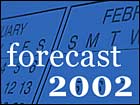|
Fair to partially sunny in 2002
|
 |
January 15, 2002: 5:35 p.m. ET
Morgan Stanley's Galbraith bets on healthcare, cyclicals and mild recovery.
By Money magazine senior writer Suzanne Woolley
|
NEW YORK (CNN/Money) - Teargassed, mugged, detained overnight in customs... and this is just a guy who worked for a bank. After serving stints in the U.K., Latin America, Hong Kong and New York City for Chase Manhattan and covering consumer goods and the securities industry for Sanford Bernstein, Steve Galbraith was recently named Morgan Stanley's chief investment officer for U.S. equity research, taking over from market master Byron Wien, who becomes senior investment strategist. Galbraith's challenge: Help clients navigate the stock market during a war and a recession in the wake of a burst bubble.
Q. What can we expect in 2002?
A. Everything we look at tells me that we're going to get some earnings growth but that it's nothing to high-five yourself about. It's going to be a gradual recovery because we are starting from such a high base of returns and high earnings. I believe in reversion to the mean and business cycles. Eighteen months ago, return on equity for U.S. corporations was the highest it had ever been in the history of the country. That scared me. It got everyone else really excited, but I think when returns are that high, capital floods into the market and screws up the equation.
Q. Would you call yourself bearish?
A. Some of our folks are very, very bearish on earnings and the economy. I'm not in that camp because returns are so low and corporate restructuring has been so profound. That suggests to me that probably in the latter part of 2002 or early 2003 you will get a nice uptick in earnings. Basically, I don't think we're heading into a global depression, but I don't think we'll have sweetness and light again. I hate this because I sound a little bit like a wimp, but I do think it's the right answer.
Q. You wrote about the economy experiencing a recovery in the shape of a mini-V. What's that all about?
A. To go from such a huge excess to such a collapse and expect a strong comeback just doesn't ring true to me. In Old Economy areas like basic materials and manufacturing, I do expect a rebound because the depth and the duration of their recession was much more profound than in a lot of areas. I have a harder time seeing a huge V-shaped recovery in financial services because we were so far above trend and business was so frenetic. We were at a positive 100-year-flood type of circumstance when the Internet came along and everyone was trading and there was so much M&A activity.
In parts of tech, you'll probably see something of a V in some of the more manufacturing-type names, like the semiconductors and anything in the hardware area. I'm not sure you get a V in some of the software businesses or things that didn't have the huge decline. Wherever you've had the largest, longest-lasting declines are the places most likely to have the biggest gains.
Q. You recommended buying cyclical stocks a few months back. Cyclicals are up about 30%. Do you still like them?
A. The situation is not quite as compelling, but the cyclicals remain relatively cheap. Stocks like Dow Chemical, Alcoa, International Paper -- the big rust-belt industries -- were so bombed out. When we get economic recovery, people will be surprised by how much these companies can earn.
Q. You've also written about buying stocks that are "stable growers." Any out there that you like now?
A. I look at whatever isn't working. While cyclicals have taken off, stable growers have lagged. These include health-care stocks like Medtronic, Abbott Laboratories, Merck and Bristol-Myers Squibb. These are defensive stocks, but I think you also need a growth component to stocks you're buying today, and health care tends to have that. Look at, say, a Medtronic. It has an initial yield of roughly 2 percent, and I can bank that. The earnings will grow 11 percent, so that's 13 percent if nothing else happens. If they just do that for a long period of time and you get a 13 percent return and the long bond is at 5 percent, I'll take that all the way to the bank. 
|
|
|
|
|
|

|

